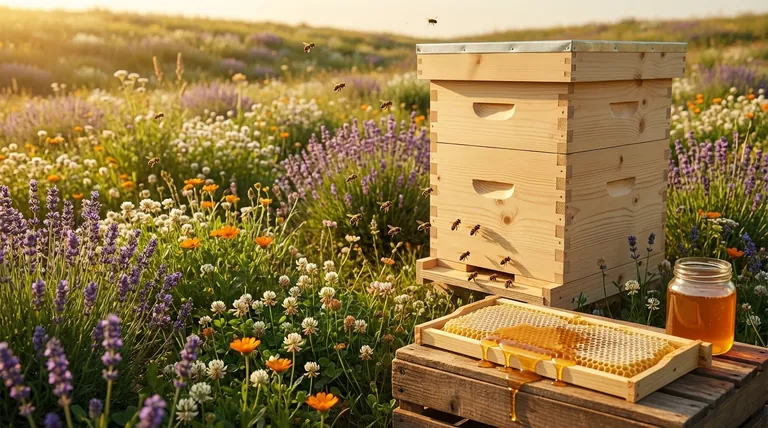In short, yes, a wooden hive can subtly influence honey's aroma and flavor, but this effect is minimal and secondary. While a new pine hive might impart a faint woody or resinous note, this is considered a minor nuance. The primary driver that overwhelmingly defines the taste, color, and scent of honey is the floral source—the specific nectar collected by the bees.
While the material of a brand-new hive might impart a faint, woody note to honey, this effect is minimal and fades over time. The single most important factor determining honey's flavor, color, and aroma is the nectar source the bees visit.

The Minor Influence of Hive Material
Many beekeepers and honey connoisseurs wonder if the container shapes the contents. While the hive material is a critical choice for the beekeeper, its impact on the final honey flavor is far smaller than most assume.
The "New Hive" Effect
The most noticeable influence occurs with a brand-new wooden hive, particularly one made from aromatic woods like white pine. The volatile oils in fresh wood can subtly infuse the air within the hive.
This may result in a faint, "woody" or "resinous" scent in the first honey harvest. However, this effect is temporary.
Why the Effect Fades Quickly
Bees work quickly to seal the interior surfaces of their hive with propolis, a resinous mixture they create from tree buds.
This propolis lining creates a natural, antimicrobial barrier between the wooden hive body and the honeycomb. It effectively neutralizes most scent transfer from the wood in subsequent seasons.
Furthermore, honey is stored in wax cells, not in direct, prolonged contact with the wood itself, further limiting any flavor infusion.
The Dominant Factor: The Floral Nectar Source
To truly understand honey flavor, you must look outside the hive and to the surrounding landscape. The nectar source is not just a factor; it is the defining characteristic.
How Nectar Defines Honey
Honey is, at its core, concentrated flower nectar. Each type of flower produces nectar with a unique chemical profile of sugars, acids, minerals, and aromatic compounds.
When bees process this nectar, they preserve these unique profiles. This is why honey from different floral sources can be radically different from one another.
Examples of Varietal Honey
The diversity of honey is a direct reflection of botanical diversity. Consider these common examples:
- Orange Blossom: Light, sweet, and distinctly citrusy.
- Clover: The classic, mild, and floral honey flavor many people recognize.
- Buckwheat: Dark, robust, and malty with a flavor profile similar to molasses.
- Lavender: Delicate and floral with a smooth, herbaceous finish.
In each case, the plant, not the hive, is responsible for the signature taste and aroma.
Understanding the Trade-offs in Hive Choice
If hive material doesn't significantly impact flavor, why do beekeepers choose one over another? The decision is based on practical beekeeping goals, not culinary ones.
Wood (Pine): The Traditional Standard
Wood is the most common hive material for good reason. It offers excellent insulation, protecting the colony from extreme heat and cold. It is also breathable, which helps regulate hive humidity.
The primary trade-off is maintenance. Wooden hives must be painted or treated to protect them from the elements and prevent rot, requiring periodic upkeep.
Plastic & Polystyrene: The Modern Alternatives
Hives made from food-grade plastic or high-density polystyrene are gaining popularity due to their durability and low maintenance. They do not rot and can last for many years with minimal care.
However, they are typically less breathable than wood, which can lead to condensation issues if not managed properly. Their insulative properties vary by design, but they represent a different set of management trade-offs for the beekeeper.
Making the Right Choice for Your Goal
Understanding what truly shapes honey's character allows you to focus your efforts where they matter most.
- If your primary focus is producing unique honey flavors: Concentrate on the location of your apiary and the diversity of the surrounding floral landscape.
- If your primary focus is efficient hive management: Choose your hive material based on your climate, budget, and desired level of maintenance.
Ultimately, the story of honey's flavor is written by the landscape, not the lumber.
Summary Table:
| Factor | Impact on Honey Flavor & Aroma | Duration |
|---|---|---|
| New Wooden Hive | May impart a faint, woody/resinous note | Temporary (first season) |
| Floral Nectar Source | Primary driver of taste, color, and scent | Defines the honey's character |
| Propolis Lining | Seals hive, minimizing scent transfer from wood | Permanent after bees seal the hive |
Ready to optimize your honey production?
At HONESTBEE, we supply commercial apiaries and beekeeping equipment distributors with the durable, high-performance supplies needed for success. Whether you manage traditional wooden hives or modern alternatives, our wholesale-focused operations ensure you get the right equipment to support your bees and maximize the quality of your harvest.
Contact our expert team today to discuss your wholesale needs and discover how HONESTBEE can be your trusted partner in beekeeping.
Visual Guide

Related Products
- Wholesales Dadant Size Wooden Bee Hives for Beekeeping
- Assembled Wooden Bee Frames with Beeswax Foundation Ready to Use by HONESTBEE
- Professional Galvanized Hive Strap with Secure Locking Buckle for Beekeeping
- Professional Drop-Style Hive Handles for Beekeeping
- Long Langstroth Style Horizontal Top Bar Hive for Wholesale
People Also Ask
- What are the advantages of wooden bee hives? Superior Bee Health & Beekeeper Flexibility
- What are the characteristics of oil-based paint for beehives? Durability vs. Modern Practicality
- Why were wooden hives traditionally preferred? For Natural Beekeeping Aligned with Bee Biology
- What should you do if you find an ant nest near your beehive? Essential Strategies for Hive Protection
- How often should the area under beehives be inspected and cleaned during the warm season? A Proactive Maintenance Guide



















